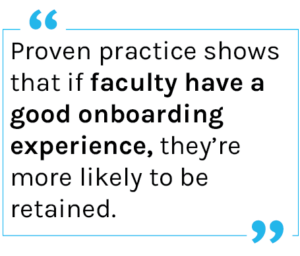In the last few years, the HigherEd landscape has undergone significant changes, leading to challenges in faculty recruitment and retention.
In a recent webinar, Best Practices for Faculty Recruitment and Retention, experts broke down some of the top challenges and solutions for both hiring and retaining faculty. Attendees heard from Janice Ward, Director of Faculty Affairs at the University of Alabama at Birmingham, and Lucas Del Priore, Product Manager at PeopleAdmin.
Read on for some key takeaways and best practices.
What are we facing?
Colleges and universities are facing new hurdles in attracting and retaining top talent. 43% of webinar attendees said that their greatest concern was that faculty positions are taking longer to fill today, while 25% said that they were most concerned about the increase in demand for remote and hybrid work opportunities.
The appeal of working in higher education has also decreased, with 77% of respondents in a Chronicle of Higher Education survey reporting that “higher education is a less appealing place to work than it was a year ago.”
Currently, 63% of HigherEd employees work on campus, 23% work in a hybrid model, and 14% work remotely. However, preferred arrangements are 32% on campus, 43% hybrid, and 28% remote, meaning that work arrangements and needs are not aligned, which can negatively impact retention.
Janice Ward noted that the fallout from the pandemic will continue to impact higher education for a long time. “At UAB, everybody’s experiencing some fallout. I’ve had faculty and leadership tell me we are working in a new normal. We can’t do business the same way anymore. We have to adjust our focus and adjust our strategies.”
So, what strategies can help?
 A focus on mental health
A focus on mental health
According to Janice, faculty today are much more aware of their mental health and much more likely to prioritize work-life balance. To support them, UAB is creating policies, processes, and initiatives around mental health and holistic employee well-being.
“For so many of us, it’s the on-campus environment and life that makes our jobs interesting and makes an institution a great place to work. The pandemic shifted all of that for a long time. We have to realize that our employees and faculty experienced loss of community, along with other losses, during the pandemic. In addition, faculty who had never used technology to that level suddenly had to teach in a fully online environment, and that extra burden left them questioning if they were valued and important, or were just being asked to do more with no extra pay, training, or positive feedback,” said Janice.
“UAB has tried to be creative and innovative to deliberately address the whole person. We’re listening to them when they say they’re burned out, and we’re providing tools to help faculty address burnout, like our wellness app. Recently, we worked with a faculty member who had a lot of responsibility, and the university jumped in with her department to work towards a path to address her burnout.”
If your institution isn’t focused on faculty well-being, it’s time to launch focused initiatives to address burnout and mental health.
Enhanced onboarding and development
UAB has also revamped their faculty onboarding program and increased their focus on development in order to improve retention.
“We enhanced our faculty onboarding with touchpoints throughout training, communication with chairs, and coaching to increase the completion rate for faculty. If they’re not completing it, you’re not succeeding. Proven practice shows that if faculty have a good onboarding experience, they’re more likely to be retained. We’ve also revamped policies to keep faculty on track for tenure, allowing extra time to take into account the new reality of work,” explained Janice.
completion rate for faculty. If they’re not completing it, you’re not succeeding. Proven practice shows that if faculty have a good onboarding experience, they’re more likely to be retained. We’ve also revamped policies to keep faculty on track for tenure, allowing extra time to take into account the new reality of work,” explained Janice.
“Beyond that, UAB has reimagined faculty development with a special focus on junior faculty development. We’ve launched a mentor matching program. We offer deliberate meet-and-greets with the provost to build community and a sense of engagement and belonging early on in employment. All of this is to make sure that faculty are engaged right away, and that they stay engaged and feel valued by the institution.”
Final thoughts
There are a number of strategies that institutions can use to make faculty recruitment easier and increase faculty retention rates. To hear more best practices, check out the on-demand webinar, Best Practices for Faculty Recruitment and Retention.
